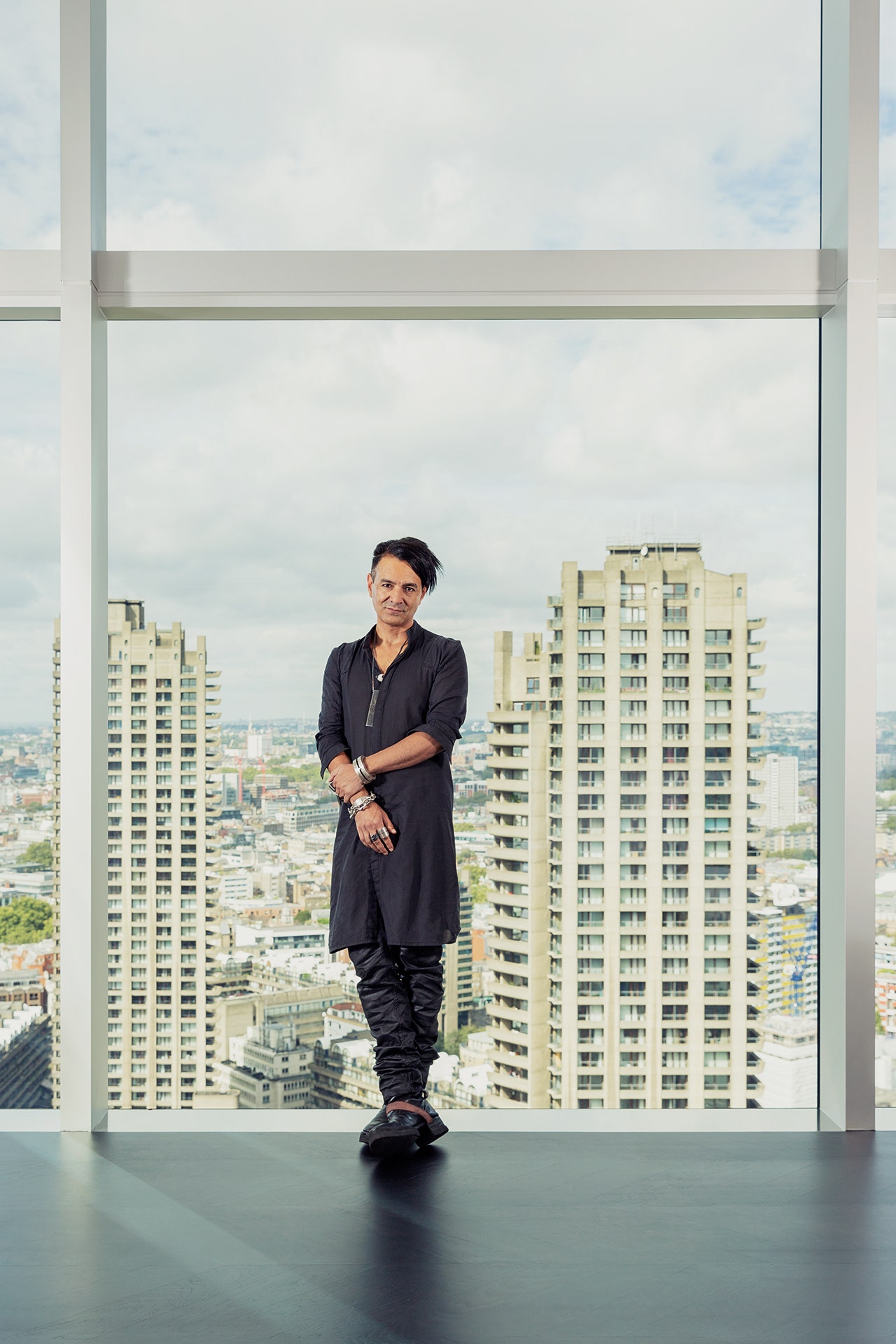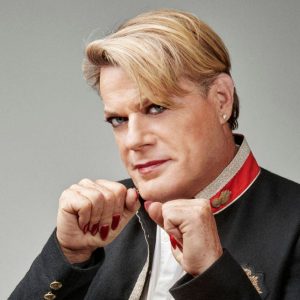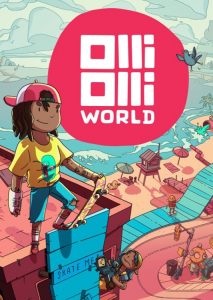
“It started to feel like a curse. It didn’t matter what we did, how much effort we put in, what we pushed – it just wasn’t working.” explains Tameem Antoniades as we discuss the reception of Enslaved – a game that was received well critically yet sold poorly.
I’ve met with Tameem to discuss his career so far, a career that has been marked with this cycle of survival followed by success, followed by survival, on repeat. It’s safe to say at this point, following Microsoft’s acquisition of Ninja Theory in June 2018, that the cycle rests on the “success” phase for the foreseeable future; it certainly feels like it as we sit down to chat in one of the many vast rooms in Tameem’s luxury Central London penthouse apartment.
- READ MORE: ‘GhostWire: Tokyo’ hands-off preview: a neon-soaked supernatural thriller
During our interview, Tameem’s wrists and fingers jangle and clink with an abundance of gothic metal jewellery as he shifts his hands from their resting position on the table. He presses his fingers to his temples, closing his eyes as he carefully chooses the right words. He is assured and affable, and we spend a while fondly discussing our childhood memories of long-dead arcades and the now ancient gaming machines of the 80s.
Obsessed with videogame culture from an early age, Tameem spent his childhood and early adulthood learning to code on the Commodore 64 and the Amiga, until he eventually found his first role in games at Millennium Interactive – the Cambridge based company who would eventually go on to become Guerilla Cambridge.

“I worked on some really awful games there.” He recalls as he chuckles. ”I think my first game was an adaptation of Raymond Briggs’ The Snowman! It was bad.”
“But I was straight out of college and I was the only programmer on it, so I got to work on every aspect of it. It was a great learning experience.”
Tameem learned the ropes on the 3DO and the Playstation, but found himself keen to move over to game design. When Sony took over Millennium Interactive, he had an opportunity to pitch.
“The game was called Moon Warrior, it was about a Shaolin monk. Kind of like Metal Gear Solid, but Kung Fu, because I was deep into kung fu movies. It was based on films like Once Upon a Time in China, stuff like that.”
Sony was interested, but Tameem encountered resistance from the old hands at the studio, who had had their own pitches rejected. As a result, Moon Warrior had no internal support.
“I found myself in a position where I was about to be fired. It was like I could do no right in people’s eyes.”
“I thought, “okay, I just want to make games and people are stopping me from making games. Why can’t I just make games?”
So began the first cycle of survival. At the age of 25, after working at Millennium for 5 years, Tameem left and founded what was then known as Just Add Monsters, along with art lead Nina Kristensen and senior technical programmer Mike Ball. The setup was less than ideal.

“We were working from Mike’s spare bedroom. We didn’t have anything, we didn’t even have computers that you could develop on! I spent three months working on a design document for a game called Kung Fu Chaos.”
“It was a kung fu game based around Jackie Chan movies. At the time those Hong Kong movies were copying western movies but adding kung fu to it and I thought right, there’s an idea – make a story about a crazy director with a ‘safety last’ approach trying to emulate American Hollywood movies using kung fu actors and make it a chaotic four-player multiplayer game.”
“I created a big design document. It was very graphical, very pretty. Not walls of text, just all diagrams and storyboards. I showed that around to people. The problem was, we’d have Disney executives and people from LucasArts come and visit us in this spare bedroom and go ‘what the fuck is this?’ ”
Eventually, Argonaut Games approached the trio, interested in buying the company. Argonaut agreed to give them total autonomy over the project and foot the bill for a proper office, more staff and some equipment they could actually develop on. In return, Just Add Monsters had to place Kung Fu Chaos with a publisher within three months. Which they did. In the very last hour of the last day of the three-month period, with Microsoft.
Kung Fu Chaos succeeded creatively but, as is often the case in game development, the goalposts were already moving, and this first taste of success was to be short-lived.
“New consoles were coming out, and games started to look more like they do now, more like blockbusters. Quirky indie-style games were massively going out of favour.”
This led Tameem to create the concept for Heavenly Sword. It was inspired by Wuxia cinema of the time – films like ‘Crouching Tiger, Hidden Dragon’ and ‘Hero’.
Bigger concepts require bigger budgets, so it was far from ideal when, mid-development cycle, Argonaut delivered the bad news.
“Argonaut called us and said ‘sorry, guys, we’ve just run out of money. We’re going bust, which means you’re going bust. You’ve got two weeks to find money if you want to try and buy out your studio.’”
“We remortgaged our houses which gave us enough money for three extra months of development. We bought back the studio with Jez [San, founder of Argonaut Games] on board as well. He put in some money and we renamed the studio Ninja Theory.”
Once again, Tameem found himself in the position of having three months to place his new game with a publisher if they were to escape closure. In a carbon copy of what happened with Kung Fu Chaos they struggled to garner interest, anxiously eyeing their rapidly dwindling funds when, at the eleventh hour, an offer came in from Sony.
“The deal we had with them wasn’t the greatest – we were just desperate to sign – so they owned the IP, they owned the technology – everything.”
To get Heavenly Sword finished, Ninja Theory was forced to expand from 20 people to 120 in just one year. With the PS3 prototype hardware constantly shifting and changing, development became nightmarish.
Much of this effort was focussed on implementing the performance capture to be found in the game’s cutscenes. Tameem tells me Heavenly Sword was one of the first games to capture everything together in one combined process – it was a new way of creating cutscenes.
Groundbreaking tech needed groundbreaking talent, and that talent came in the form of an incredible chance encounter with Lord of the Rings actor Andy Serkis.
“My brother was a mortgage advisor, and he happened to be doing Andy’s mortgage. I remember seeing Gollum and saying ‘that’s what a CG character should be like.’ So when my brother said he’s got Andy Serkis coming in to do a mortgage. I said ‘can you show him our trailer and ask him if he wants to work on games?’ and he did!”
“He called me and said ‘this is cool. What do you want to do?’ And I said, ‘Well, I don’t know anything about stories, or characters, or directing, or writing. If you come on board would you mind…doing all that?’”
“And so he did all of that – he cast everyone and he helped with the story writing.”

He introduced us to Weta Digital [Peter Jackson’s digital studio] and we flew out to Weta for six weeks with the cast. We shot everything on set there. That was the first time we used performance capture – face, body voice. I actually think it was the first time Weta had used performance capture.”
At this point, you’d forgive Tameem for thinking success was on the horizon, yet the cycle would continue. The game didn’t sell enough and Sony wasn’t interested in a sequel unless they were totally in charge.
The studio’s next title, Enslaved: Odyssey To The West, signed by Namco, followed the exact same pattern; the last-minute scramble to sign the game was followed by a promising development and a unique story co-written by Alex Garland (28 Days Later, Sunshine, Ex Machina), with Serkis playing the lead.
And yet, history repeated itself.
Tameem was frustrated and exhausted with the process, so it was a relief when the studio was approached by Capcom to develop the next Devil May Cry game. It was an established series with a history of good commercial performance. What could go wrong?
“The development of DmC was great but, from the announce trailer, which was very early in development, it was a disaster. It was prototype gamergate levels of hate.”
Part of Ninja Theory’s brief was to put their own Western spin on the series. This took the form of a younger, gobbier Dante, the usual long flowing gothic hairstyle replaced by a much shorter, industrial style undercut.
“I probably said a few things in interviews I shouldn’t have said that riled everyone up. The level of hate was phenomenal. I thought it would be good to just shut out the noise and make the best game possible.”
“All the hate was directed at me. I’m pretty sure I was at one point the most hated designer in video games. I also thought I’m gonna make this the best game I can possibly make and then I’m out. It’s just not rewarding – so far the journey’s not been rewarding’”
Despite DmC selling as well as the other Devil May Cry titles, a sequel was not forthcoming. Single-player games were going out of fashion and Ninja Theory was forced to split into smaller teams and take on a variety of smaller projects – mobile games, VR games; they became a pay-for-hire studio.
“I think I was done three times over, really. But I stayed because we were constantly in survival mode. It felt like if I’d left, I’d be abandoning the team, people would lose their jobs and it would turn ugly. I wasn’t satisfied creatively either, so I felt like I needed to give this another stab.”
This would be the birth of Ninja Theory’s self-published, self-marketed, “budget AAA” BAFTA-hoovering hit, Hellblade. I ask Tameem whether he thinks the difficulties he had faced by that point in the industry had given him the requisite experience to plan and fund an independent title.
“It gave me the confidence to know how to develop. But I had no confidence in the business model, I had no confidence in publishers looking after you. You’re responsible for what goes out there. But behind the scenes, there are a lot of people telling you what they want, otherwise you don’t get paid. Everything felt wrong with the model, everything’s stacked against you. ”
“So I thought, let’s make something that looks AAA, but shorter, and we’ll sell it at half the price. And we’ll do it digital only. We had no data on digital at all, no one wanted to release on digital. So we had no idea whether it was feasible.”
Heavenly Sword, Enslaved, and Hellblade exist as a sort of unofficial trilogy; Hellblade is so-called because it is a direct reference to Heavenly Sword – a declaration of unfinished business.
“In Heavenly Sword, Nariko’s sidekick Kai could see things – she was living in another world of sorts. And so the concept was, what if she grew up? What would she be like? That’s where that idea for Hellblade came from – if we had another stab at Heavenly Sword but in a different world, in a different universe, what would it look like?

“All I’ve ever wanted to do since childhood is make films that you can play. I learned directing, casting and story development from Andy Serkis, but I learned to write with Alex Garland on Enslaved. We worked together for two years. I was his apprentice and co-writer, I learned so much from him. When it came to Hellblade I had those two experiences, so I decided it was time to do it on my own.”
“Alex Garland had just told us about a concept that he had, which became the film Ex Machina. He said ‘there’s going to be three speaking parts, one location and a small team. We’re going to do it on a low budget and we’re going to make it look as good as we possibly can.’ That struck a chord with me.”
“So for Hellblade I thought, right, let’s restrict it to one character; let’s use performance capture; let’s build our own stage to support that one character. We’ll have one environment artist, one character artist, one audio person, one of everyone – keep the team as small and tight as possible.”
Hellblade won three Game Awards, five BAFTAs, and was recognised outside of the games industry by the Royal College of Psychiatrists for its depiction of psychosis in the form of the Psychiatric Communicator of the Year award.
Now the curse is finally broken, the team is concentrating on making the sequel the best it can be. Will Hellblade 2 be a perfection of the format Tameem has been working on for most of his career?
“The goal with Hellblade 2 isn’t to perfect it, but to create an experience that feels more believable and more refined. Its ambition in terms of scale is bigger. I think Hellblade 2 will make Hellblade look like an indie game.”
This ambition takes the form of an all-encompassing approach to the concept of “capturing reality”. Forty locations in Iceland were scouted, narrowed down then scanned into the game’s engine as is; level designers weren’t allowed to invent new pathways or structures. Real costumes were made and scanned, the textures built from scanning pieces of ancient material. The team even employed a combat trainer so that Melina Juergens – the game’s lead actor – could perform all the in-engine combat herself.
“The idea is believability – making things look real or believable – and the best way to do that is to base everything on real things.”
Where Hellblade was a personal journey into one woman’s psychosis, the sequel will ask bigger questions about religion and society, linking psychotic episodes to the religious visions of historical figures such as Joan of Arc.
“Psychosis is defined as having hallucinations and beliefs that aren’t grounded in reality. You can apply that to a lot of things, a lot of beliefs, but it should only be classed as an illness if it impedes your life in some way. Otherwise, it’s just a different way of thinking.”
“Hellblade 2 moves away from this being a personal affliction for Senua and more about how a person like that can change the world.”
In the same way Senua’s world has deepened and widened, Tameem’s ambition is to extend Ninja Theory’s reach beyond the often insular world of video games and aim for a broader cultural impact.
“My interest is to get outside of that bubble and ask questions like ‘how can we make an impact in mental health by doing a project that’s not games related? How do we make an impact in digital art? How do we connect with the rest of the cultural world and just go off on a tangent – still make games, but go off on a tangent and do our own thing?’”
“Following the pack has never worked for us – I did that for 15 years before realising it just doesn’t work for us.”
“Hellblade was a tangent, so we’ll just continue going off on tangents and doing things that other people don’t think of or can’t risk doing. We’re part of a big organisation now, so I think we are almost obliged to take chances that no one else has the privilege of taking. The technology and lessons of games are really valuable and rich and important, it’s so far advanced from the expectations of people outside of games.”
“That should be a force for good ideally, but it’s definitely a force for change.”
Gareth Dutton is a writer and photographer from London.




